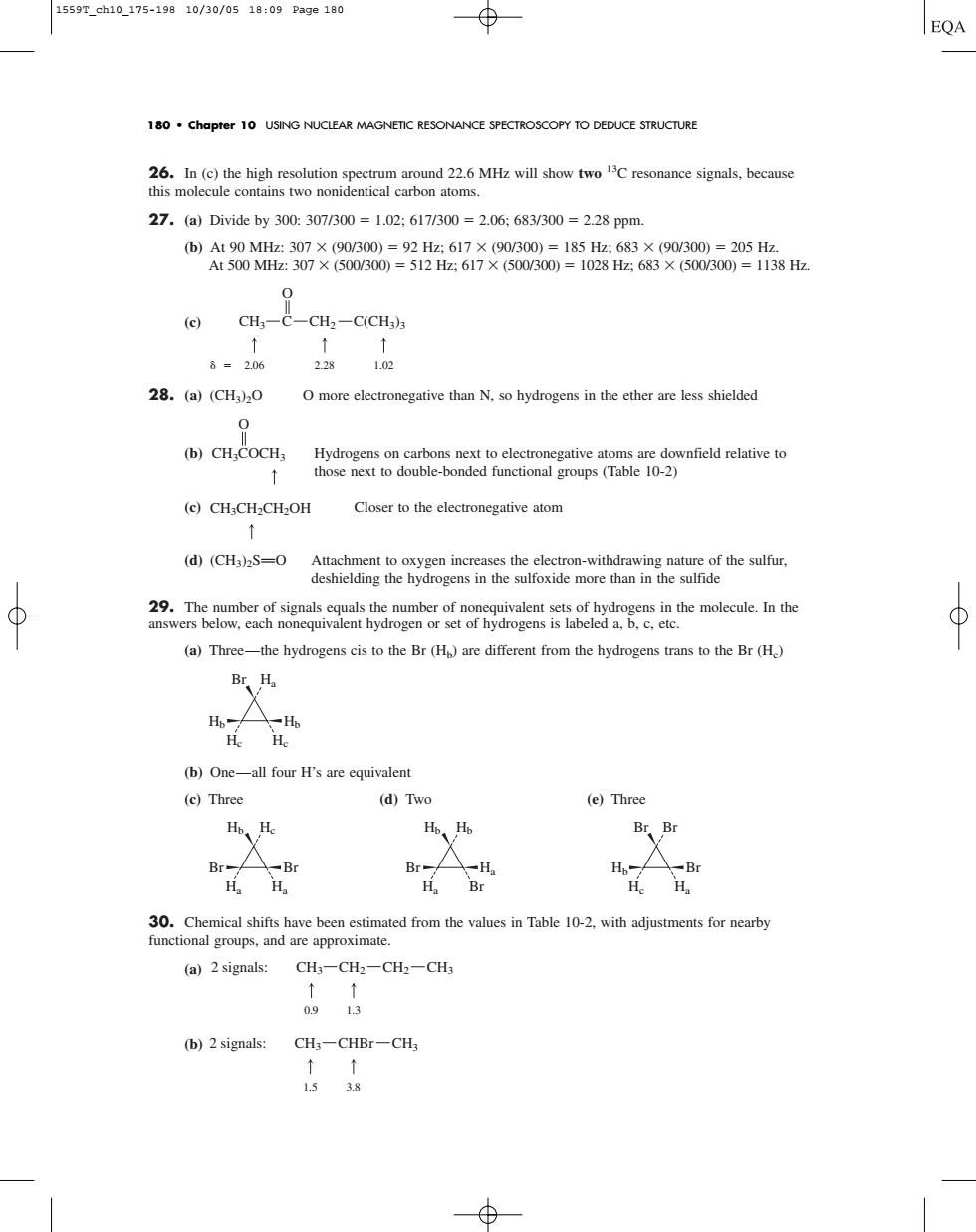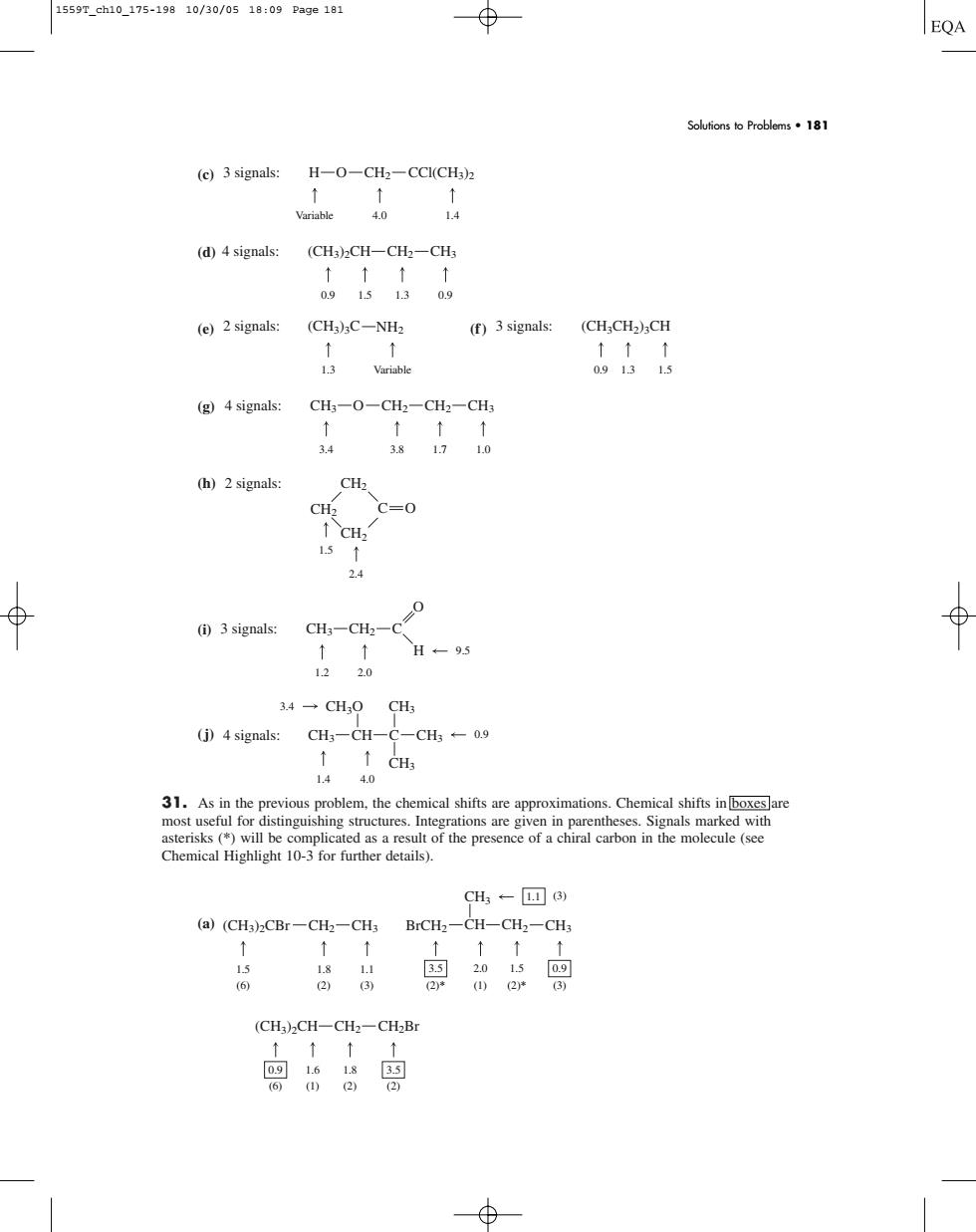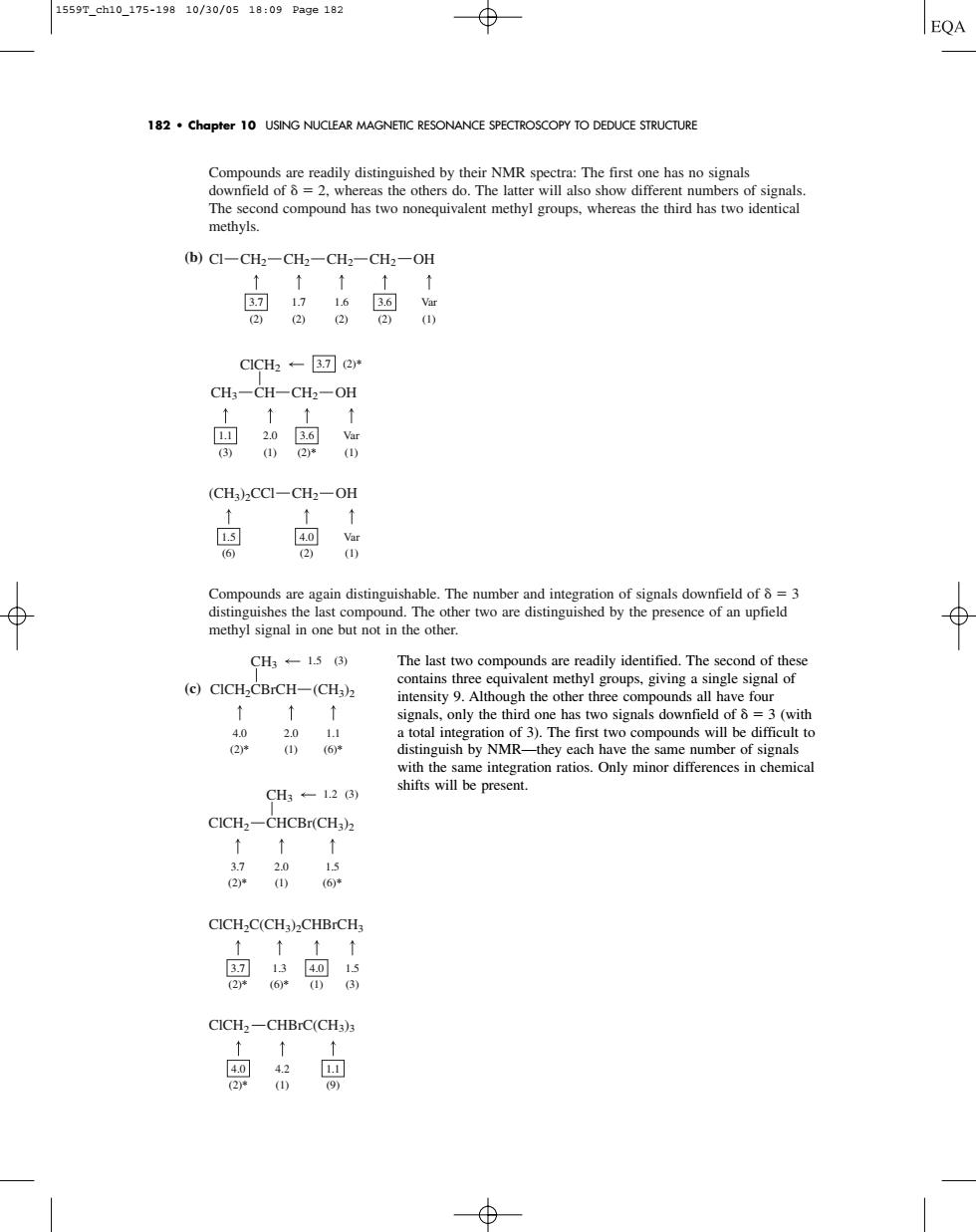
1559rch10175-19910/30/0518:09Pag0180 180.chapter 10 USING NUCLEAR MAGNETIC RESONANCE SPECTROSCOPY TO DEDUCE STRUCTURE uns two non carbon atoms. 27.(a)Divide by300:307/300=1.02:617/300=2.06:683/300=2.28ppm (e)CH3-C-CH2-C(CH3)3 8-206 228 1.02 28.(a)(CH)20 Omore electronegative than N.so hydrogens in the ether are less shielded (b)CH,COCH, (c)CH:CH2CH2OH Closer to the electronegative atom (d)(CH3)2S-O 29.The number of signals equals the number of nonequivalent sets of hydrogens in the molecule.In the answers below,each nonequivalent hydrogen or set of hydrogens is labeled a,b,c.etc. (a)Three-the hydrogens cis to the Br(H are different from the hydrogens trans to the Br(H) Br H. H。 (b)One-all four H's are equivalent (c)Three (d)Two (e)Three Ho He BrBr Br- H Br H H 30.Chemical shifts have been estimated from the values in Table 10-2.with adjustments for nearby functional groups,and are approximate. (a)2 signals: CH3-CHz-CH2-CH3 0913 (b)2 signals:CHs-CHBr-CH3 1.53.8
26. In (c) the high resolution spectrum around 22.6 MHz will show two 13C resonance signals, because this molecule contains two nonidentical carbon atoms. 27. (a) Divide by 300: 307/300 1.02; 617/300 2.06; 683/300 2.28 ppm. (b) At 90 MHz: 307 (90/300) 92 Hz; 617 (90/300) 185 Hz; 683 (90/300) 205 Hz. At 500 MHz: 307 (500/300) 512 Hz; 617 (500/300) 1028 Hz; 683 (500/300) 1138 Hz. (c) 28. (a) (CH3)2O O more electronegative than N, so hydrogens in the ether are less shielded (b) Hydrogens on carbons next to electronegative atoms are downfield relative to those next to double-bonded functional groups (Table 10-2) (c) Closer to the electronegative atom (d) (CH3)2SPO Attachment to oxygen increases the electron-withdrawing nature of the sulfur, deshielding the hydrogens in the sulfoxide more than in the sulfide 29. The number of signals equals the number of nonequivalent sets of hydrogens in the molecule. In the answers below, each nonequivalent hydrogen or set of hydrogens is labeled a, b, c, etc. (a) Three—the hydrogens cis to the Br (Hb) are different from the hydrogens trans to the Br (Hc) (b) One—all four H’s are equivalent (c) Three (d) Two (e) Three 30. Chemical shifts have been estimated from the values in Table 10-2, with adjustments for nearby functional groups, and are approximate. (a) (b) 2 signals: CH3 CHBr CH3 1.5 3.8 2 signals: CH3 CH2 CH2 CH3 0.9 1.3 Hb Br Hc Ha Br Br Br Ha Ha Br Hb Hb Br Br Ha Ha Hb Hc Hb Hb Hc Hc Br Ha CH3CH2CH2OH O CH3COCH3 CH3 C CH2 C(CH3)3 O 2.06 2.28 1.02 180 • Chapter 10 USING NUCLEAR MAGNETIC RESONANCE SPECTROSCOPY TO DEDUCE STRUCTURE 1559T_ch10_175-198 10/30/05 18:09 Page 180�

1559T_ch10_175-19810/30/0518:09Pa9e181 EQA Solutions to Problems.181 (c)3 signals: H-O-CH2-CCI(CHa) 14 (d)4signals:(CH3)2CH-CH2-CH3 11↑↑ 09151309 (e)2 signals:(CHa)C-NH2 (f)3 signals:(CH;CH2)CH ↑↑1 1.3 Variable 091315 (g)4signals:CH3-O-CH2-CH2-CHs 38171.0 (h)2 signals: 15 2 :C-C ↑↑H-95 1220 34一CH,0CH (j)4 signals:CH3-CH-C-CH309 1↑C 1440 3 for further details). CH←回) (a)(CHa)CBr-CH2-CH3 BrCH2-CH-CH2-CHs (CH3)2CH-CH2-CH2Br
(c) (d) (e) (f ) (g) (h) (i) (j) 31. As in the previous problem, the chemical shifts are approximations. Chemical shifts in boxes are most useful for distinguishing structures. Integrations are given in parentheses. Signals marked with asterisks (*) will be complicated as a result of the presence of a chiral carbon in the molecule (see Chemical Highlight 10-3 for further details). (a) 1.5 1.8 1.1 (6) (2) (3) (CH3)2CBr CH2 CH3 1.1 2.0 (1) 1.5 (2)* 0.9 (3) (3) CH3 CH3 BrCH2 CH CH2 3.5 (2)* CH3 CH3 CH3 CH3 CH CH3O 4 signals: 4.0 0.9 3.4 1.4 C 3 signals: CH3 CH2 2.0 9.5 1.2 C H O CH2 CH2 O 2 signals: 1.5 2.4 CH2 C 4 signals: CH3 O CH2 3.4 3.8 1.7 1.0 CH2 CH3 3 signals: (CH3CH2)3CH 0.9 1.3 1.5 2 signals: (CH3)3C NH2 1.3 Variable 4 signals: (CH3)2CH CH2 CH3 0.9 1.5 1.3 0.9 3 signals: H O CH2 CCl(CH3)2 Variable 4.0 1.4 Solutions to Problems • 181 0.9 1.6 1.8 (6) (1) (2) 3.5 (2) (CH3)2CH CH2 CH2Br 1559T_ch10_175-198 10/30/05 18:09 Page 181

1559r.ah10.175-19810/30/0518:09Page182 182.chapter 10 USING NUCLEAR MAGNETIC RESONANCE SPECTROSCOPY TO DEDUCE STRUCTURE NMR spectra:The first one has no signals Theomaaleethen methyls. (b)Cl-CHz-CH2-CH2-CH3-OH ↑↑↑↑1 2 C1CH2←-3司a* CH;-CH-CH2-OH 宫”丽州 (CH3)2CCl-CH2-OH 因 Compounds are again distinguishable.The number and integration of signals downfield of=3 由 CH←15 The last two co unds are readily identified.The s (e)CICH2CBrCH-(CH3)2 contains three a total in distinguis byonty minor ditferencesin h ica on fanos. CH3-128 shifts will be present. ClCH2-CHCBr(CH3)2 ClCH.C(CH,)CHBrCH, 回:回台 CICH2-CHBrC(CH3) 恩品
Compounds are readily distinguished by their NMR spectra: The first one has no signals downfield of 2, whereas the others do. The latter will also show different numbers of signals. The second compound has two nonequivalent methyl groups, whereas the third has two identical methyls. (b) Compounds are again distinguishable. The number and integration of signals downfield of 3 distinguishes the last compound. The other two are distinguished by the presence of an upfield methyl signal in one but not in the other. (c) 4.2 (1) ClCH2 CHBrC(CH3)3 4.0 (2)* 1.1 (9) 1.5 (3) 1.3 (6)* ClCH2C(CH3)2CHBrCH3 3.7 (2)* 4.0 (1) 3.7 (2)* 1.5 (6)* 2.0 (1) CH3 ClCH2 CHCBr(CH3)2 1.2 (3) 4.0 (2)* 1.1 (6)* 2.0 (1) CH3 ClCH2CBrCH (CH3)2 1.5 (3) Var (1) 4.0 (2) (CH3)2CCl CH2 OH 1.5 (6) 2.0 (1) Var (1) 3.6 (2)* (2)* OH ClCH2 CH3 CH CH2 1.1 (3) 3.7 3.7 1.7 1.6 (2) (2) (2) Var (1) 3.6 (2) Cl CH2 CH2 CH2 CH2 OH 182 • Chapter 10 USING NUCLEAR MAGNETIC RESONANCE SPECTROSCOPY TO DEDUCE STRUCTURE The last two compounds are readily identified. The second of these contains three equivalent methyl groups, giving a single signal of intensity 9. Although the other three compounds all have four signals, only the third one has two signals downfield of 3 (with a total integration of 3). The first two compounds will be difficult to distinguish by NMR—they each have the same number of signals with the same integration ratios. Only minor differences in chemical shifts will be present. 1559T_ch10_175-198 10/30/05 18:09 Page 182���